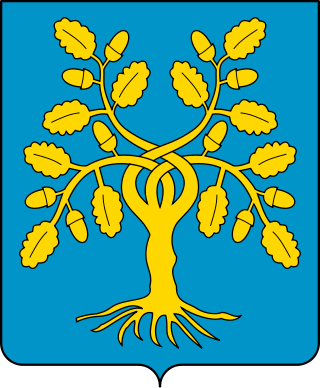
The House of Della Rovere was a powerful Italian noble family. It had humble origins in Savona, in Liguria, and acquired power and influence through nepotism and ambitious marriages arranged by two Della Rovere popes: Francesco Della Rovere, who ruled as Sixtus IV from 1471 to 1484 and his nephew Giuliano, who became Julius II in 1503. Sixtus IV built the Sistine Chapel, which was named after him. Julius II was patron to Michelangelo, Raphael and many other Renaissance artists and started the modern rebuilt of St. Peter's Basilica. Also the Basilica of San Pietro in Vincoli in Rome was the family church of the Della Rovere. Members of the family were influential in the Church of Rome, and as dukes of Urbino, dukes of Sora and lords of Senigallia; the title of Urbino was extinguished with the death of Francesco Maria II in 1631, and the family died out with the death of his granddaughter Vittoria, Grand Duchess of Tuscany.
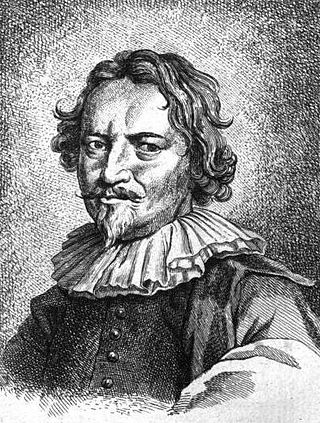
Carlo Fontana (1634/1638–1714) was an Italian architect originating from today's Canton Ticino, who was in part responsible for the classicizing direction taken by Late Baroque Roman architecture.

San Francesco a Ripa is a church in Rome, Italy. It is dedicated to Francis of Assisi who once stayed at the adjacent convent. The term Ripa refers to the nearby riverbank of the Tiber.
The School of Ferrara was a group of painters which flourished in the Duchy of Ferrara during the Renaissance. Ferrara was ruled by the Este family, well known for its patronage of the arts. Patronage was extended with the ascent of Ercole d'Este I in 1470, and the family continued in power till Alfonso II, Ercole's great-grandson, died without an heir in 1597. The duchy was then occupied in succession by Papal and Austrian forces. The school evolved styles of painting that appeared to blend influences from Mantua, Venice, Lombardy, Bologna, and Florence.

Gualtieri is a comune (municipality) in the province of Reggio Emilia, in the Italian region of Emilia-Romagna, located about 70 kilometres (43 mi) northwest of Bologna and about 25 kilometres (16 mi) north of Reggio Emilia on the right bank of the Po river. Historically, it suffered numerous floods, the last occurring in 1951. It is one of I Borghi più belli d'Italia.

Giovanni Battista Naldini (1535–1591) was an Italian painter in a late-Mannerist style, active in Florence and Rome.

Pier Francesco Mazzucchelli was an Italian painter and draughtsman who was active in Milan. He is mainly known for his altarpieces, but his outstanding achievements are large decorative frescoes for the Sacro Monte di Varese and the Sacro Monte di Varallo.

The Tempio Malatestiano is the unfinished cathedral church of Rimini, Italy. Officially named for St. Francis, it takes the popular name from Sigismondo Pandolfo Malatesta, who commissioned its reconstruction by the famous Renaissance theorist and architect Leon Battista Alberti around 1450.

Francesco Salviati or Francesco de' Rossi was an Italian Mannerist painter who lived and worked in Florence, with periods in Bologna and Venice, ending with a long period in Rome, where he died. He is known by various names, usually the adopted one of Francesco Salviati or Il Salviati, after an early patron, but also Francesco Rossi and Cecchino del Salviati.

Blessed Ludovica Albertoni is a funerary monument by the Italian Baroque artist Gian Lorenzo Bernini. The Trastevere sculpture is located in the specially designed Altieri Chapel in the Church of San Francesco a Ripa in Rome, Italy. Bernini started the project in 1671, but his work on two other major works—The Tomb of Pope Alexander VII and the Altar of the Blessed Sacrament in St. Peter's Basilica—delayed his work on the funerary monument. Bernini completed the sculpture in 1674; it was installed by 31 August 1674.
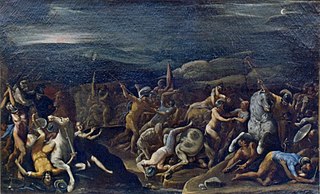
Gaspare Celio was an Italian painter of the late-Mannerist and early-Baroque period, active mainly in his native city of Rome.
Giovanni Guerra (1544–1618) was an Italian draughtsman and painter from Modena who worked in Rome. He probably arrived in the city as early as 1562, though he was not documented until 1583, when he frescoed three friezes of allegorical figures in the Palazzetto Cenci, a modest project for a patron who was not very prestigious.

Italian Baroque art is a term that is used here to refer to Italian painting and sculpture in the Baroque manner executed over a period that extended from the late sixteenth to the mid eighteenth centuries. Italian Baroque architecture is not covered.
Claudio Francesco Beaumont was an Italian painter, active in a late baroque-style mostly in the Piedmont region.

San Giacomo in Augusta is a Baroque church in Rome, Italy. It was the church of the Hospital of San Giacomo degli Incurabili.
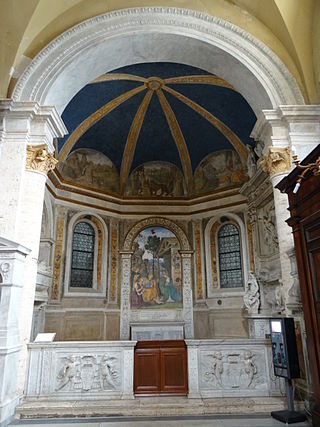
The Della Rovere or Saint Jerome Chapel, otherwise the Chapel of the Nativity is the first side chapel in the south aisle of the Basilica of Santa Maria del Popolo in Rome. It was dedicated to the Virgin and Saint Jerome and decorated with the paintings of Pinturicchio and his pupils. It is one of the best preserved monuments of quattrocento art in Rome.

Giovanni Battista Ricci nicknamed Il Novara after his birth town, was an Italian painter of the late-Mannerist and early-Baroque period, active mainly in Rome.

San Vitale is a Baroque style, Roman Catholic church located in central Parma, region of Emilia Romagna, Italy. it stands just east of the Palazzo del Comune and Piazza Garibaldi.
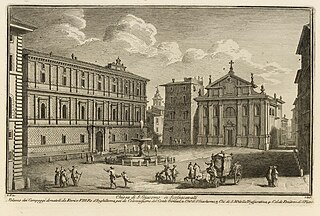
San Giacomo Scossacavalli was a church in Rome important for historical and artistic reasons. The church, facing the Piazza Scossacavalli, was built during the early Middle Ages and since the early 16th century hosted a confraternity which commissioned Renaissance architect Antonio da Sangallo the Younger to build a new shrine. This was richly decorated with frescoes, painted by mannerist artist Giovanni Battista Ricci and his students. The church was demolished in 1937, when Via della Conciliazione was built and the piazza and central part of the Borgo rione were demolished. Many decorative elements still exist, since they were preserved from demolition.

Emilio Santarelli was an Italian sculptor active mainly in Florence.

















